
Obesity is a common problem in our society and we should address it because it affects our health. This also extends to our dogs; we shouldn’t neglect dog obesity either.
But, how can you get your dog’s weight under control?
Find out the cause of your dog’s obesity, how to get your dog’s weight under control, and also to rule out other potential diseases!
Understanding Dog Obesity
According to The Kennel Club, canine obesity is one of the fastest-growing health concerns affecting dogs today and can occur in dogs of all ages and types. It is estimated that between 30% and 60% of dogs are overweight.
Signs of Dog Obesity
These are the signs that indicate that your dog is overweight:
- Not being able to feel his rib cage.
- Your dog’s weight is over the average for his breed and age.
- When looking at your dog from the side, his waist isn’t obvious or/and his shape not being wider at the chest and thinner at the abdomen.
- No more interest in physical activities, i.e. going for walks.
- No more stamina – he gets tired very easily.
- A bigger and rounder face.
- Difficulty walking.
- Easily getting out of breath.
- Frequently being tired or sleeping a lot.
- A thick fatty neck.
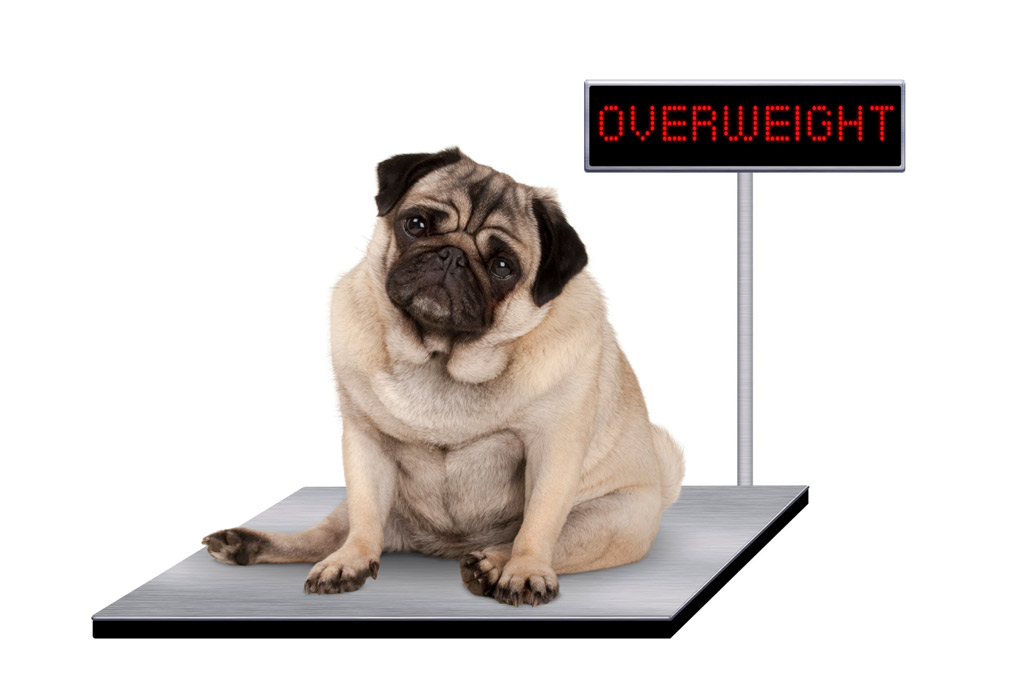
Effects of Dog Obesity
The effects of your dog becoming overweight may not be noticeable straight away, but your family and friends might be able to detect it sooner than you if they don’t see your dog often.
Nevertheless, dog obesity can have a large impact on a dog’s life.
Obesity can lead to:
- A shorter lifespan: Dogs fed a healthy and controlled diet during their lifetime have been shown to live much longer lives than those which are overweight. A study showed that obese dogs live 1.8 years less than their lean counterparts.
- Heart and breathing problems: Fat can build up in the chest and around the airways, making breathing much more difficult and increasing blood pressure. Tracheal collapse is common in many small breeds. Same goes for the brachycephalic syndrome, the respiratory difficulty that occurs in some short-faced dogs like pugs, which can worsen when overweight.
- Hormonal disease: Large stores of fat can make the body become resilient to the effects of the hormone insulin, making it much more difficult to regulate blood glucose levels, leading to canine diabetes.
- Osteoarthritis or joint disease: Excessive body weight puts stress on joints and can affect a dog’s risk of ligament rupture and arthritis. Likewise, the inflammatory state obesity causes in the body also contribute to poor joint health. After developing these conditions, it may be painful for a dog to move and exercise, making it more difficult for them to lose weight.
- Heat intolerance: Overweight dogs are far more likely to suffer (or even die) from heatstroke than dogs of a healthy weight.
- Skin disease: Nonallergic skin diseases have been documented at higher rates in dogs with excess weight.
- Cancer: Some types of cancers appear to be more common in overweight or obese dogs.
- Decreased activity: It causes a lack of tolerance for exercise.
In addition, it can also:
- Worsen the risk of incontinence.
- Increase the risk of urinary tract infections.
- Increase the risk of complications from anaesthesia and surgery.
- Increase the risk of pancreatitis.
- Worsen the risk of kidney disease.
The good news is that reducing your dog’s weight can reverse most of these consequences and risks. A dog with a healthy weight and who is in shape is more likely to enjoy a long and happy life, which is rewarding for both you and your dog.
Factors that Contribute to Dog Obesity
- Exercise: Your dog’s physical activity plays an important part in maintaining a healthy weight. Exercise keeps him fit and agile; plus, it also helps to prevent digestive problems. If your dog doesn’t burn calories, he’s likely to become obese.
- Diet: If your dog’s diet it’s not balanced and the quantity is not fixed, this can lead to weight gain problems. In fact, regular treats contribute to unhealthy weight imbalances.
- Age: If older dogs continue to eat the same quantity but are more likely to be less active, they can easily put on weight.
- Neutering or spaying: When dogs go through this procedure, their metabolic rate lowers and the energy that they require decreases by about a third. So, they can put on weight easily if their diet and exercise are not adjusted accordingly.
- Genetics: Although any dog can become overweight, research has found that dogs of certain breeds may be more prone to being overweight than others, suggesting a possible genetic component. Breeds said to be predisposed to becoming overweight include Labrador Retrievers, Cavalier King Charles Spaniels, Cocker Spaniels and Beagles.
- Social aspects: Dogs that live with other dogs or cats may tend to eat more, or eat more quickly, than those in a single dog household. However, dogs that don’t live with other pets tend to be spoilt more with treats. So either way, watch out for how much food your dog eats daily.
- Personality: Some dogs may only eat what they need to, while others will eat everything that is given to them and will still look for more. Some dogs are fussy about which foods they eat, while others will eat anything.
- Medications: Some medications, such as glucocorticoids, benzodiazepines and barbiturates can all increase the risk of weight gain.
- Other health problems: Conditions such as Cushing’s syndrome (a disease of the adrenal gland), hypothyroidism (an underactive thyroid), and insulinoma (a tumour in the pancreas) can all lead to weight gain.
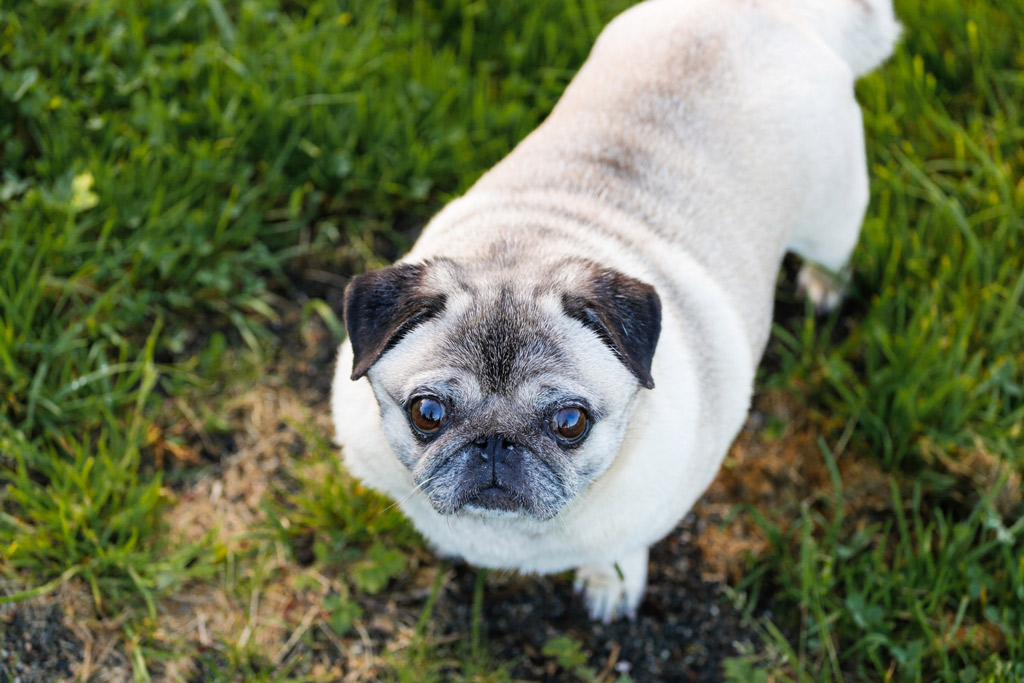
Before Getting Started, Rule Out Diseases
Apart from biologically inappropriate diets, there can be a variety of causes for constant hunger in dogs, including:
- Canine biology.
- Memories of food scarcity.
- Learned behaviour.
- An underlying disease.
Above all, the first stop for an extra-hungry dog should be the veterinarian, since a number of serious underlying diseases can cause excessive hunger, including:
- Cushing’s syndrome.
- Diabetes
- Hyperthyroidism.
- Exocrine pancreatic insufficiency (EPI).
Cushing’s Disease or Hyperadrenocorticism
This condition occurs when adrenal glands release too much cortisol (fight-or-flight hormone). Your dog needs cortisol in small amounts. Adrenal glands intermittently release cortisol in small amounts in response to perceived stress and the possibility the dog might have to do battle or run for his life.
However, if he experiences chronic stress, his adrenals will release too much cortisol in response – plus it triggers a release of glucose from the liver. Chronic stress leads to persistent oversecretion of cortisol. Extreme hunger is one of the symptoms of Cushing’s and results from the body burning all that extra glucose.
Diabetes
Obesity is the biggest reason a dog becomes diabetic. Unfortunately, Type 2 diabetes is very common in dogs approaching middle age and their senior years.
Your dog has no biological requirement for grains or most other carbohydrates like starches. Yet carbs can be as much as 80% of the ingredients in processed dog food, and the dry food manufacturing process requires starches, to begin with. Even grain-free foods contain an abundance of sugar in the form of tapioca, potato, pea and other legumes that can stress your dog’s pancreas.
All those carbs in commercial dog food turn into sugar in your dog’s body and that excess sugar leads to diabetes.
On the other hand, lack of physical activity is another lifestyle-related reason for dogs to develop diabetes. We will address exercise further down, in step 7.
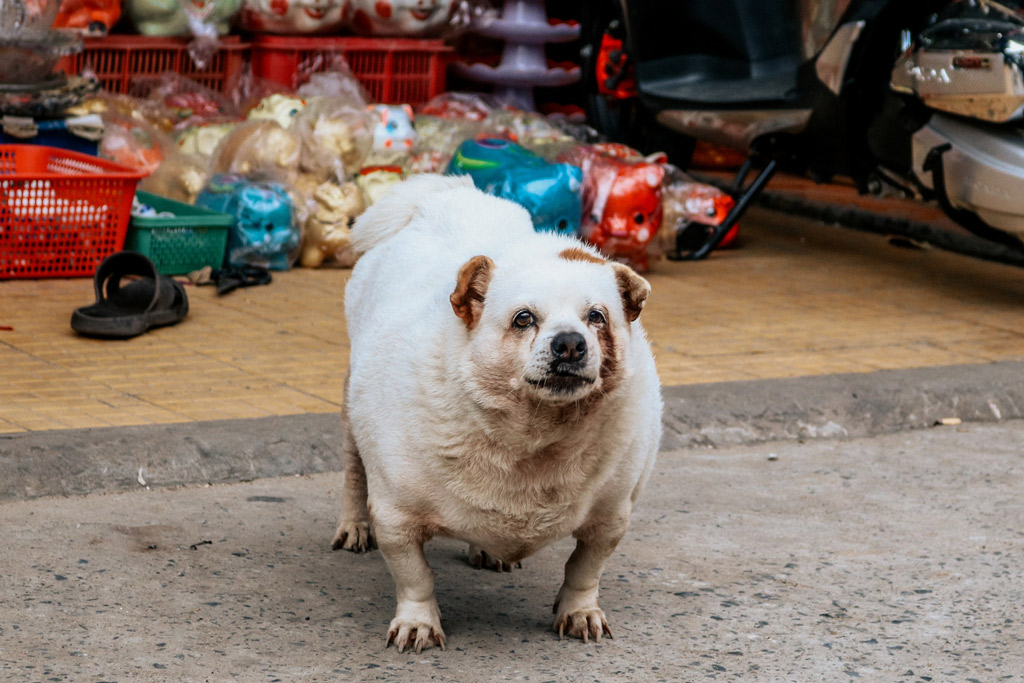
Hyperthyroidism
This is typically seen in older cats, so is an uncommon condition in dogs. In most cases, the main cause is an aggressive thyroid tumour that overproduces thyroid hormone.
Your dog’s body temperature, heart rate, food utilization and other functions depend on the appropriate levels of the thyroid hormone in the bloodstream. Hyperthyroidism means the glands are working overtime and secreting too much hormone, which causes a constant state of metabolic hyperactivity. If it’s not treated, hyperthyroidism can cause heart and kidney failure.
Dogs with this condition typically have the following symptoms:
- Weight loss despite being constantly hungry.
- They drink excessive amounts of water and urinate a lot.
- Increased heart rates.
- Vomiting.
Exocrine Pancreatic Insufficiency (EPI)
The pancreas has many functions: it produces not only insulin but also various enzymes that are crucial to the digestive process.
Pancreatic enzymes include:
- Amylase, which breaks down starches.
- Lipase, which breaks down fats.
- Trypsin and chymotrypsin, which break down proteins.
When your dog eats, the pancreas gets a signal to release digestive enzymes. They travel into the small intestine via the pancreatic duct and they break down food particles. They allow nutrients from the diet to be absorbed by the cells of the intestine, where they pass into the bloodstream and are transported throughout the body for use by tissues.
On the contrary, if there is a decrease or lack of digestive enzymes being produced by the pancreas, your dog suffers from EPI. As a consequence, proteins, starches, and fats from the diet aren’t broken down sufficiently to be absorbed through the intestinal wall.
This means nutrients can’t get into the bloodstream to supply nourishment to the body’s tissues and much of the food that is eaten remains undigested in the gastrointestinal tract and ultimately leaves the body in faeces. If left untreated, a dog with EPI can literally starve to death despite eating.
Signs your dog may be dealing with EPI include:
- Weight loss.
- Constant hunger.
- Loose stools that may have a foul odour and contain large quantities of undigested fat.
- Poor coat condition.
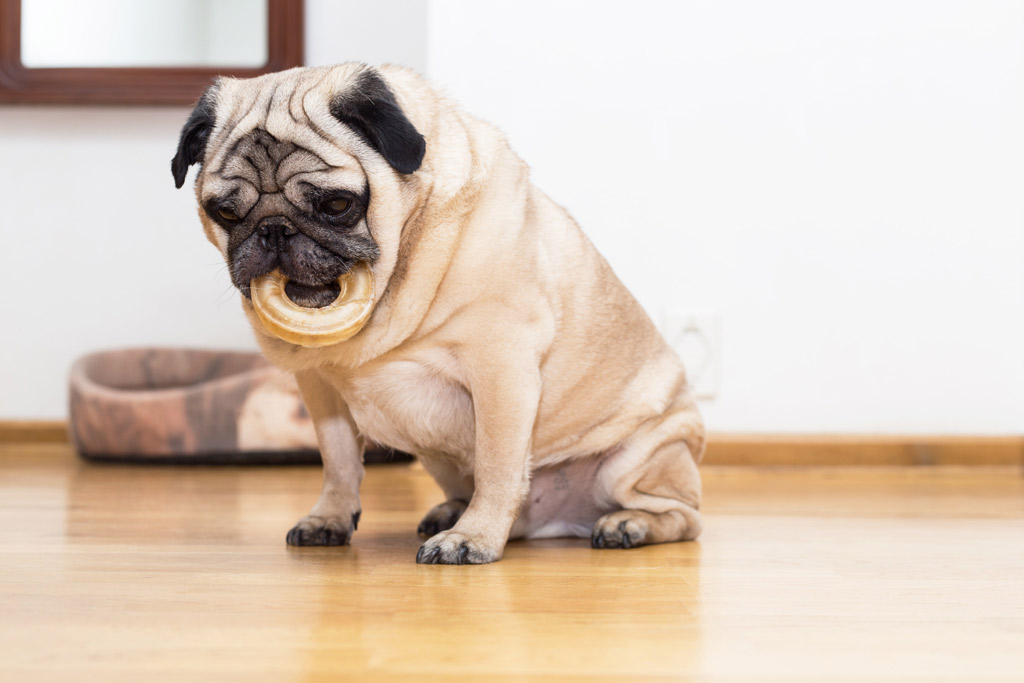
Dog Weight Management Steps
So how can you get your dog’s weight under control?
After you have ruled out that your dog is not suffering from any of the diseases mentioned above, it’s a safe bet to proceed with this weight management steps.
Follow these 7 steps to reduce your dog’s obesity and improve his health.
#1 – Avoid Inappropriate Dog Food
Processed dog food containing grains, starches and added fibre can create malnourishment at the cellular level, leaving your dog feeling hungry.
Your dog’s biological requirement for fibre and carbs (starch) is little, which means when fibre replaces protein in the diet, your dog can end up obsessively searching for more amino acids.
In addition, too much fibre can block the absorption of necessary nutrients into the small intestine. This can create a barrier preventing the gastrointestinal tract from absorbing antioxidants, vitamins and trace minerals.
While your furry friend will feel full only temporarily, he will remain undernourished at the all-important cellular level. This can result in feelings of constant hunger, a sign that your carnivorous dog isn’t getting sufficient protein to adequately sustain his biology.
In summary, avoid too much fibre and cut down the carbs.
#2 – Ignore Begging
Dogs who learn that begging and other food-seeking activities get results will continue the behaviour until it is no longer rewarded. That’s why you must master the art of self-control and learn to ignore begging in order to avoid overfeeding your doggy.
You can try to:
- Feed your dog more frequent meals, i.e. divide the total daily calorie intake into more portions.
- Add water and veggies to his food bowl to increase the volume but not the calories.
- Distract your dog with games or take him for a walk.

#3 – Ignore Weight Loss Frauds
Fibre is an especially popular ingredient in weight loss and low-fat dog food formulas and has also been studied as a potential remedy for annoying canine food-seeking behaviours such as whining, begging, food stealing and trash/dumpster diving. Plus, fibre is meant to make your dog feel full.
However, feel free to ignore any dog food marketing ploy aimed at making you believe the newest fibre-filled bag of “weight loss” dog food is the answer to your dog’s obesity. Dogs need a limited amount of fibre.
#4 – Follow a Balanced Diet
Regardless of your dog’s weight, he still needs the right nutrition. So feed your dog a nutritionally balanced, species-appropriate diet, with appropriate supplementation if necessary. This means foods that are high in animal protein and moisture, with low or no grain content.
Also, you can introduce raw food (meat and vegetables), cooked veggies and natural supplements like Omega-3 and Tumeric.
If your dog follows this type of diet, it’s unlikely that his food-seeking behaviour is related to malnourishment. In that case, your furry friend may have an underlying condition that is interfering with his body’s ability to properly digest nutrients from his diet.
For more about dog nutrition, check our Dog nutrition: the ultimate guide to your dog’s balanced diet blog post.
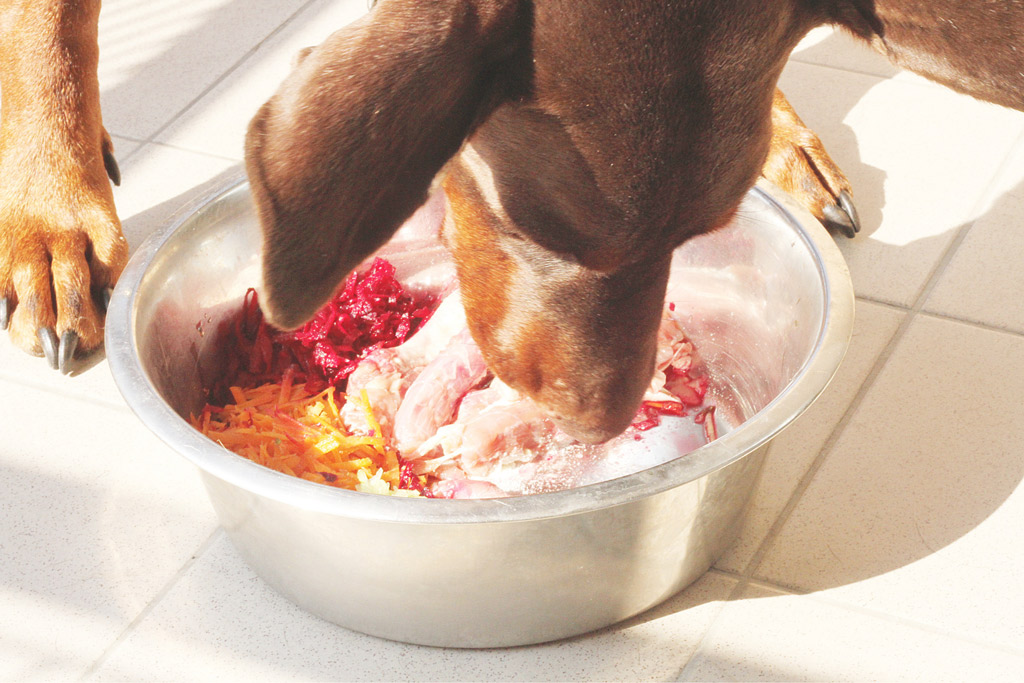
#5 – Calculate the Food Quantity
It’s essential to know how much food your dog needs to reach his ideal body weight. This is probably the most overlooked step in weight loss success.
Also, it’s important to monitor your puppy’s weight whilst growing up. It’s a great way to know that you are feeding him the right quantity.
Dog weight calculator:
Daily calories (canine) = Body Weight (kg) x 30 + 70
#6 – Set a Feeding Schedule and Keep Track of Weight Changes
Avoid free feeding. Setting feeding times help you have a routine and help control exactly how much your dog is eating.
You can weigh your dog at home as long as he can fit in your house scale. Otherwise, you can take him to your vet to measure his weight and check his progress.
Monitor your dog’s weight loss and increase or decrease his calorie intake to make sure you are hitting the target rate.
Ideally, your dog will be losing between 0.5 – 2.0% of his starting body weight per week. Initially, he may lose weight at a faster rate because of a loss of water weight. So, if you see he has lost more than 2% per week early on, there’s no need to adjust his daily food serving.

#7 – Practice Portion Control
Avoid inconsistent portioning. After calculating the daily food intake, you can practice portion control. Typically you should feed your dog a morning and evening meal, carefully measured.
A high-protein, low-carb diet with the right amount of calories for weight loss, controlled through the portions you feed, is what will take the weight off your dog. And don’t forget to factor in any calories from treats.
#8 – Daily Exercise Is a Must
Finally, exercise! It seems to be the right thing to do to tackle many problems. So, regularly exercise your pooch. An overweight body gets back in shape by taking in fewer calories and expending more energy.
Daily exercise, including at least 20-30 minutes of consistent aerobic activity, will help your dog burn fat and increase muscle tone. It’s also important to be consistent like your schedule feeding times, also follow a routine for dog walks and playtime.
If you want to know more about how much exercise your dog needs and how often, check our How often should I walk my dog blog post. However, if you don’t have much time for walking your dog, check my favourite dog care option.
Insider Tip: Stay consistent during and after he has lost weight!
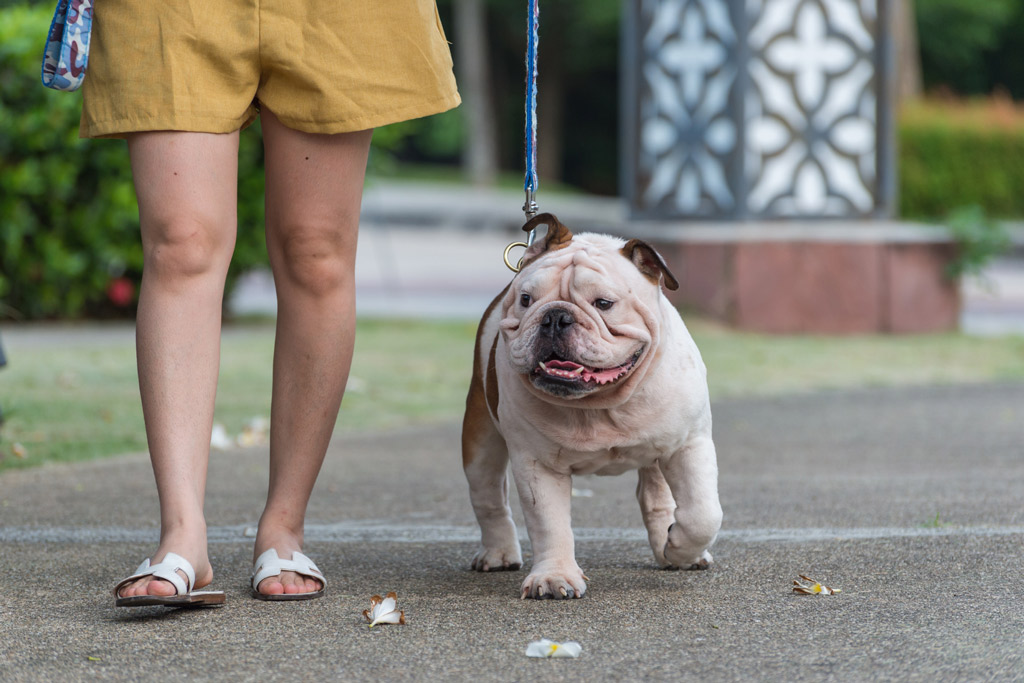
Finally, for more about dog care, check out our The 5 pillars to a happy and healthy dog blog post.
Related Questions

Our. Rescue shitzue-Pom, is the love of our workd! She has gotten too many treats,
Which we know now is the problem. She is on a raw food chicken diet, Some baby
Food –2 teaspoons of chicken in broth, or beef in broth, and 1 1/2 teas. Light yougert
She gets this a.m. And p.m. Before bed, she get one dog bone. We walk our lane way,
About 1 mile every day. Please tell me what we need to do
Hello Connie!
Thank you for your question 🙂
To begin with, you should calculate how much food quantity you should feed your pooch according to age. This is the most important thing to do since you already feed your pooch a balanced diet!
As a reference: for a 5-10kg adult dog with an average exercise routine, between 100-150g/day.
Once you know that, you can divide that food quantity during the day as your usual schedule. If there’s any treat you want to give her, make sure is part of the daily meal allowance. By doing so, you will prevent overfeeding your pooch.
Also, exercise helps to keep your dog mentally and physically active, burning away the extra fat. Since you got a small doggie, I would say 30 minutes of exercise daily. You can divide this into two walks if you like and add some playtime too. If 1 mile takes you less than 30 minutes, I would increase every walk by a minute to give her some time to adjust.
I had to take care of an overweight pug and although the exercise was a challenge (she will stop everywhere!), it helped her to reduce weight too.
Finally, in doubt, always check with your vet!
Hope this helps 😉 Let me know how you are doing 🙂
Take care,
Lily